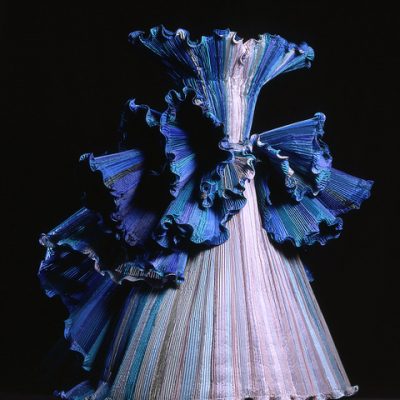
Designers 20.04.2021
06.09.2022
artdesignItalian fashionperformance
In occasion of “Cinzia says…”, the first major retrospective of Italian artist and fashion designer Cinzia Ruggeri, Dr Elena Fava introduces us to the fantastic, eerie, kaleidoscopic world of the designer with two guest posts and rare archive material
Cinzia Ruggeri: the Body, the Dress and the Stage
Getting dressed is the first thing you do every morning: neglected, refined, ‘normal.’ Whether you want it or not, the dress is the (always intentional) performance of ourselves. (Cinzia Ruggeri, 1983)
These are the words Cinzia Ruggeri used to present the clothing project she conceived for the photography course Nuove tendenze italiane nella creazione di immagini hosted in the rooms of Palazzo Fortuny in Venice in December 1983. On this occasion, Ruggeri presented the video Per un vestire organico, directed by Metamorphosi, in which she transferred the research she was conducting in fashion design.
The set is the eccentric Milanese showroom of Bloom, the company and the women’s clothing brand through which Ruggeri conquered the Milanese prêt-à-porter catwalks since the early seventies, and that would show collections throughout the 1980s as well. The protagonist is a marine creature, played by the dancer Valeria Magli who, swathed in a blue suit with suckers, slips between objects, immersed in a pink painted environment, oversaw by a fake angel by Piero della Francesca leaning out of a fake pulpit. Much like an octopus, Magli clings to these contemporary totems to get to know them, and then writhes on them, harnesses them and in the end is completely seduced by them; a mysterious ritual consumes, originated from the daily habit of dressing, and from a body wired by its second skin, the dress, the real catalyst of the connection with the surrounding world.
These are the years in which architects and philosophers elaborate on definitions of modernity; artists and critics gather under the labels of Transavanguardia or Nuovi-nuovi, Alchimia designers knead the languages of the historical avant-garde to work on the concept of the banal, intended as an aesthetic of everyday life. The multimedia research of Cinzia Ruggeri populate the composite magma composing Postmodernism; the varied output of her work would position her as one of the celebrated ‘symbolic’ figures of that season, for the subversive charge of her projects and considered an embodiment of an intellectual and sophisticated fashion that shaped femininity as the right to express emotions.
Ruggeri’s collections for Bloom and for the most avant-garde line bearing her name launched in 1981 demonstrate the propensity for experimentation and the taste for technological research, such as the application of liquid crystals on textiles that changed colour depending on body temperature, futuristic kinetic decorations activated under polarized lights, or bright LEDs between the flounces of an evening dress that lights up with a gesture. The experiments invested materials and structure of the models that became pointed stairs in homage to Lévi-Strauss, evanescent ziggurat, fragrant walls on which gardens grow which everyone could cultivate at will.
Cinzia Ruggeri’s fashion was sensory and emotional, at times spectacular, always ironic, but absolutely portable – according to journalist Silvana Bernasconi – which claims the physical dimension of the experience as necessary.
In addition to dresses that at once would cloth the body and express emotions, Ruggeri’s research over the years expanded coherently to the environment, with furniture projects, set design, various installations and an intense exhibition activity that engaged the designer until her death in November 2019.
**The text, in a more extended version, was presented by Elena Fava and Marta Franceschini, for the FADC Fashion and Design Conference: Creation & Research. 1st Interdisciplinary Meeting on Design and Fashion Studies, Universidade de Vigo, 2020, and published in the proceedings of the conference (pp. 263-271).